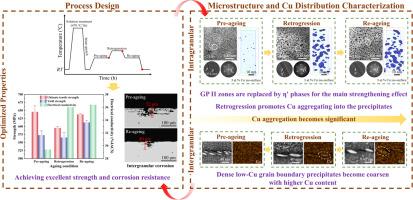回顾7055铝合金在连续回时效和再时效过程中强度和组织的演变
IF 14.3
1区 材料科学
Q1 MATERIALS SCIENCE, MULTIDISCIPLINARY
引用次数: 0
摘要
系统研究了7055铝合金在两种冷却速度下的连续回退再时效(CRRA)过程中强度和组织的演变规律。结果表明:GP II区是预时效阶段后的主要强化阶段,Zn/Mg和(Zn + Cu)/Mg比值分别为1.24和1.36;在退化处理过程中,这些颗粒逐渐转变为η相,在长达90 min的时间内阻止强度降低。同时,溶质Cu原子通过取代Zn和Al原子而不是Mg原子而分裂成聚集体(团簇、GP II区和η′相),导致crra处理样品的聚集体与预时效样品的组成存在差异。此外,在热处理后进行空冷(3300°C/h)有利于通过二次析出提高强度,而炉冷(45°C/h)进一步提高了电导率,增加了基体析出相和晶界析出相中的Cu含量,但不降低屈服强度。本文章由计算机程序翻译,如有差异,请以英文原文为准。

Revisiting the evolution of strength and microstructure of aluminum alloy 7055 during continuous retrogression and re-ageing treatment
The evolution of strength and microstructure in aluminum alloy 7055 during a continuous retrogression and re-aging (CRRA) treatment with two retrogression cooling rates was systematically investigated. The results reveal that GP II zones serve as the primary strengthening phase after the pre-ageing stage, characterized by Zn/Mg and (Zn + Cu)/Mg ratios of 1.24 and 1.36, respectively. During the retrogression treatment, these particles progressively transform into η′ phases, preventing strength reduction for the duration up to 90 min. Meanwhile, solute Cu atoms partition into aggregates (clusters, GP II zones, and η′ phases) by substituting for Zn and Al atoms rather than Mg atoms, resulting in compositional differences between aggregates in CRRA-treated samples and the pre-aged sample. Additionally, air cooling (3300°C/h) following the retrogression treatment facilitates strength improvement through secondary precipitation, while furnace cooling (45°C/h) further improves the electrical conductivity and increases Cu content in both matrix precipitates and grain boundary precipitates without deteriorating the yield strength.
求助全文
通过发布文献求助,成功后即可免费获取论文全文。
去求助
来源期刊

Journal of Materials Science & Technology
工程技术-材料科学:综合
CiteScore
20.00
自引率
11.00%
发文量
995
审稿时长
13 days
期刊介绍:
Journal of Materials Science & Technology strives to promote global collaboration in the field of materials science and technology. It primarily publishes original research papers, invited review articles, letters, research notes, and summaries of scientific achievements. The journal covers a wide range of materials science and technology topics, including metallic materials, inorganic nonmetallic materials, and composite materials.
 求助内容:
求助内容: 应助结果提醒方式:
应助结果提醒方式:


